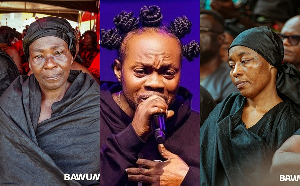Opinions of Sunday, 26 August 2018
Columnist: Cameron Duodu
Kudos, Kofi Darko Asante!
It would have been easy to be overwhelmed by the sheer grandeur of the durbar held at Kyebi on 23 August 2018 by the Okyenhene, Osagyefo Amoatia Ofori Panin, at which the Asantehene, Otumfuo Osei Tutu The Second, was the guest of honour.
The durbar was to commemorate the 75th anniversary of the death of Okyenhene Osagyefo Nana Sir Ofori Atta The First. Of late, reports of rancour between politicians of Akyem Abuakwa and those Asante had made it to the media. So people wondered whether the Asantehene would really grace the occasion.
But the sceptics were shamed when the Asantehene arrived with no less than 21 of his Amanhene.
So, just imagine the amount of talk of gold ornaments that were displayed on the persons of chiefs. Of richly-coloured hand-woven cloths of incredible craftsmanship; of umbrellas of various sizes, colours and patterns; of caps and head-gear; of hand-held weapons and smocks littered with amulets – all tastefully designed and each item unique in its category.
There were also sounds to hear. Drums: vying with each other to proclaim the great deeds of the ancestors of the current Kings and chiefs. Horns seeking to imitate the diction of the bards of old who could compose words to be blown on horns in such as way that they could be understood by the human ear.
Add to all this the voices of minstrels specially trained to praise their masters’ past deeds, sometimes in a historically archaic language not even understood by those trained to declaim it.
Yes – two giants of Ghanaian culture had decided to parade their physical and spiritual finery to each other in friendly greeting and in acknowledgement of a common origin – Adanse. It was pleasant to watch and uplifting to understand.
The two Kings spoke of their personal friendship and also revealed that their two Stools had been keeping in touch with each other in the recent past. As I watched the spectacle, a bizarre thought crossed my mind: how could the vibrant culture of these two people have given birth to today’s generation of earth wreckers who do not scruple to destroy their own people’s drinking water with excavators, bulldozers and changfang machines that dig up ancient riverbeds in search of gold?
How come people can be taught to play the drums and declaim the praise-songs of their stools but cannot understand that if you want to dig for gold, you must learn where to place your pits and how to wash the sand and pebbles you bring up from underground?
How can people work their hands to the bone to educate their children, and yet watch unconcerned when these “educated” akrakyefuor bring Chinese fortune-hunters into their homes and smuggle them into farms where they dig in such a haphazard manner, looking for gold, that when they leave the farms, there are not only huge craters left to be filled with greenish water but also heaps and heaps of soil that form tall ridges that make it impossible merely to walk on the land again, let alone use it to plant plantain, cocoyam, cassava or maize?
As I watched the display, I realised that we in Ghana live in a surreal world made up of two layers – an outer layer that presents a most beautiful spectre to the strange, in the form of our manner of dressing; our eloquent turn of phrase; and our philosophical approach to life. But pry open the thin layer of skin on the surface and get to the flesh and what do you find? A lust for money that overrides both our traditional beliefs and our imported epistemology; we have priests who make a living out of fleecing those afraid of death; and we have self-styled “leaders of morality” who chair publicly-financed banks and turn them into private treasure troves.
And we mostly say nothing about any of it. I was crying in my heart as I watched the Kyebi durbar, crying over this paradoxical situation we face socially – when the microphone was given to someone I couldn’t at first recognise.
The man began to speak. It turned out to be my old friend, Kofi Darko Asante. Two sentences and he was already on his way to the nitty-gritty. Our chiefs should please offer serious support to the President, Nana Addo Dankwa Akufo-Addo, in his endeavour to stop galamsey, which is destroying our water-bodies and farmlands.
“When I was a at Prempeh College and coming home during the holidays” (he said) “the trains from Kumase used to stop at Anyinam, in Akyem Abuakwa. That was the longest stop. Why? All the train’s passengers wanted to drink water there. Water from Birem Abenaa. Today, when I go to any of the Akyem villages where I have family, I drink sachet water [“Pure Water”! I drink “Pure water” at Kwabeng. I drink “Pure Water” at Apinamang. I drink “Pure Water” at Abomosu! Meanwhile, Birem Abenaa, whose purity once made the Akyems boast: “Meye Okyenkwaa a menom Birem” has become a mud-filled discoloured body of water. “
Mr Darko Asante made a vigorous plea to the chiefs to back the anti-galamsey struggle. They were not as “powerless” as they claimed, he said. For people told them things….
Will he be listened to? I would like to inform our chiefs that Kofi Darko Asante is a trained diplomat who would not have found it easy to speak as he did, aware as he is of the demands of “protocol”. He is using his training to alert them the disaster that they are courting for their people with their apathetic attitude towards the destruction of our water bodies. He certainly deserves the thanks of all Ghanaians.














